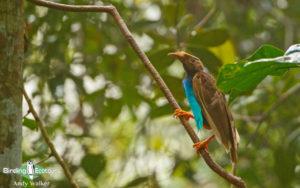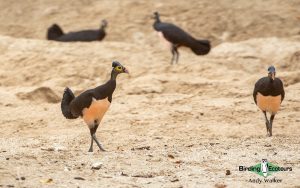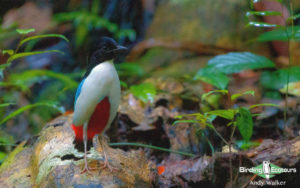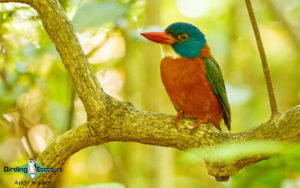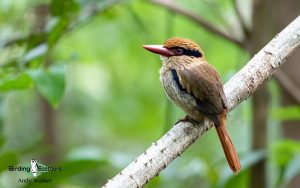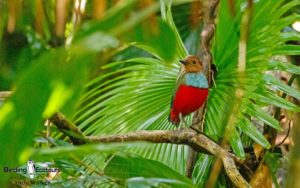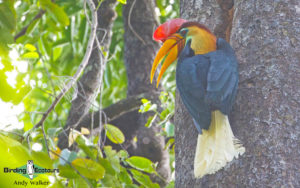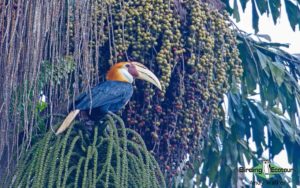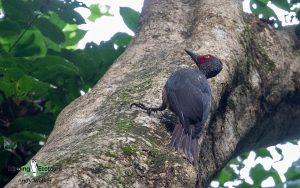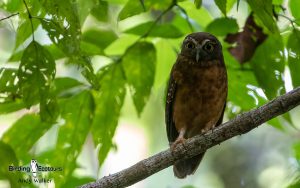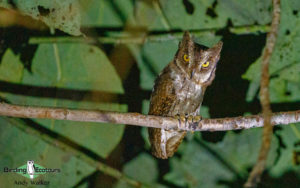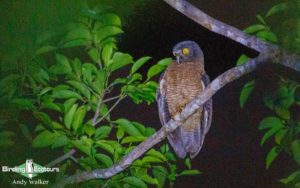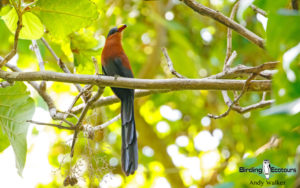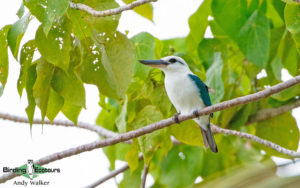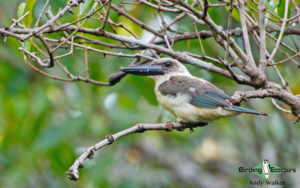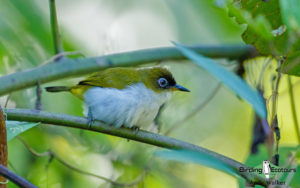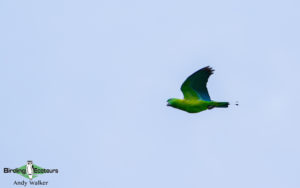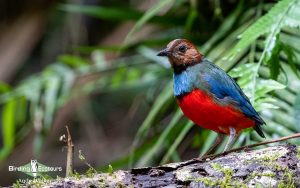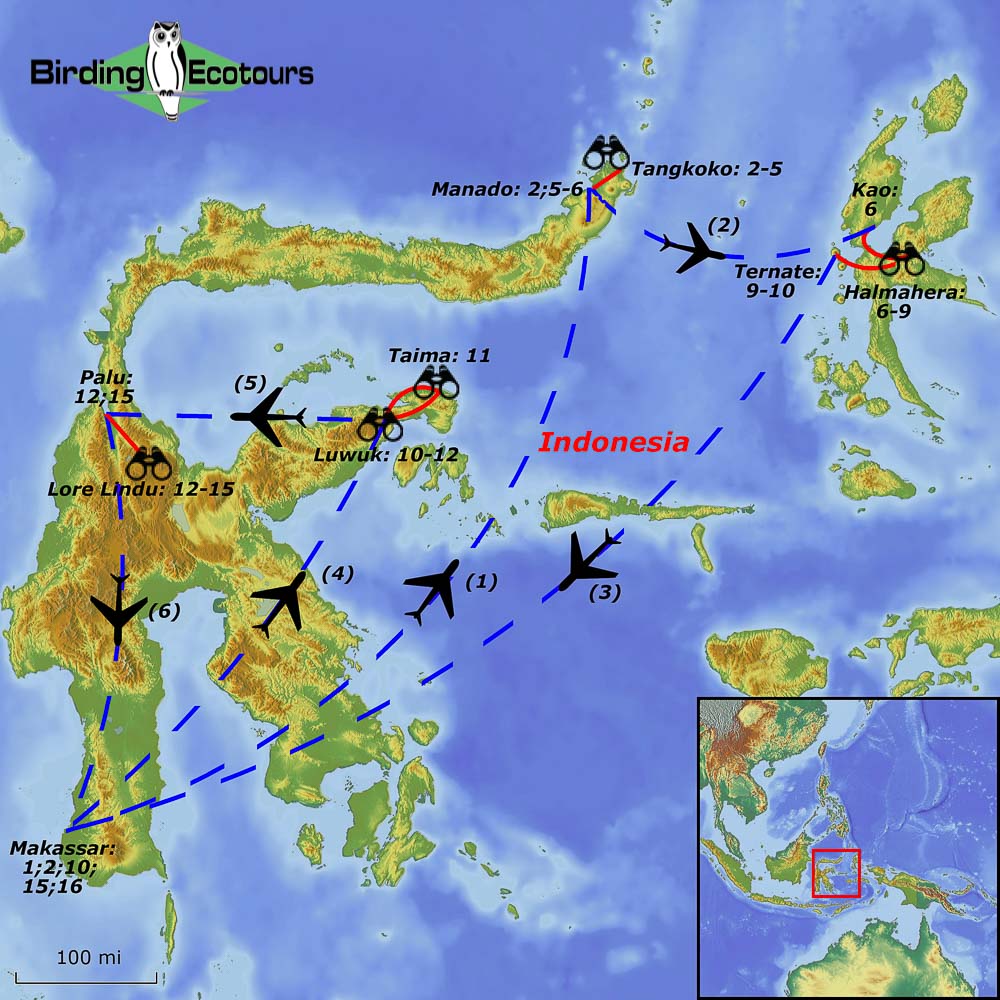Birding Tour Indonesia: Sulawesi and Halmahera – Spectacular Endemic Birding
Sulawesi and Halmahera – Spectacular Endemic Birding
July 2026/August 2027
This small-group birding tour in Indonesia visits the two endemic-filled islands of Sulawesi and Halmahera. These two islands straddle the equator and sit between the islands of Borneo to the west and New Guinea to the east. They also offer some of the best birding on the planet (and some good photo opportunities). Sulawesi, accessed through its capital city Makassar, in the southwest of this interestingly shaped island (also a convenient international arrivals entry point into Indonesia and the start/end point of our tour), is the westernmost of the two islands and is part of the Greater Sundas (along with Borneo, Sumatra, and Java). The other island, Halmahera, is more Australasian in nature and is part of the North Maluku Islands (also known as the Moluccas). We enter Halmahera through the town of Kao, in the north, and depart from Sofifi in the west via a speedboat to the small island of Ternate, to the west of Halmahera (the closest airport to Sofifi).
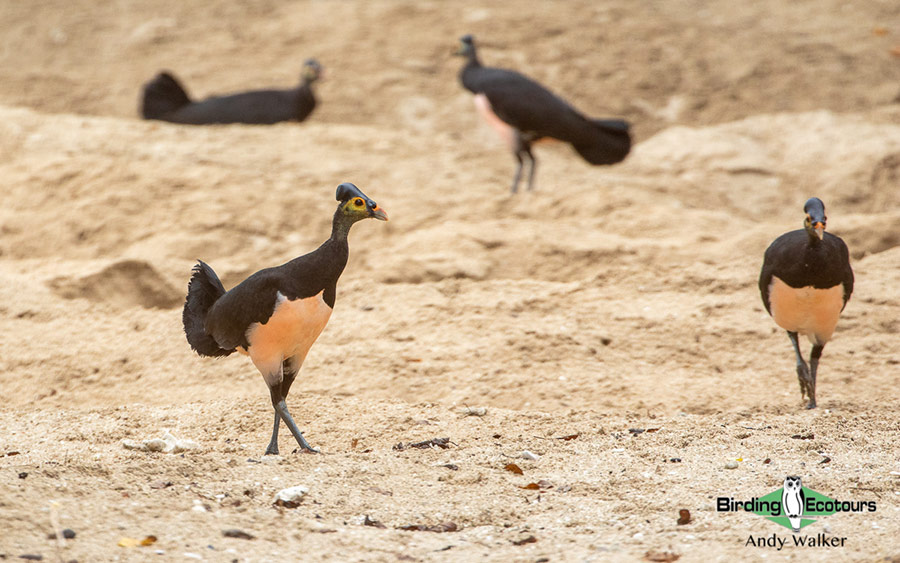
This tour provides some incredible birding opportunities with a dose of adventure too, likely to leave you with a firm desire to explore further throughout this bird-filled Indonesian archipelago. Both islands are to the east of the famous Wallace Line, an invisible faunal boundary line which divides the biogeographical realms of Asia and Wallacea (a transitional zone between Asia and Australia) and named after the British naturalist Alfred Russel Wallace. The avifauna of Sulawesi and Halmahera is distinctly Wallacean, headlined by the bizarre mound-nesting megapode, Maleo on Sulawesi and the Standardwing (also known as Wallace’s Standardwing or Standardwing Bird-of-paradise), whose raucous calls echo through the forests on Halmahera, as they bounce around their display leks – a magical sight.
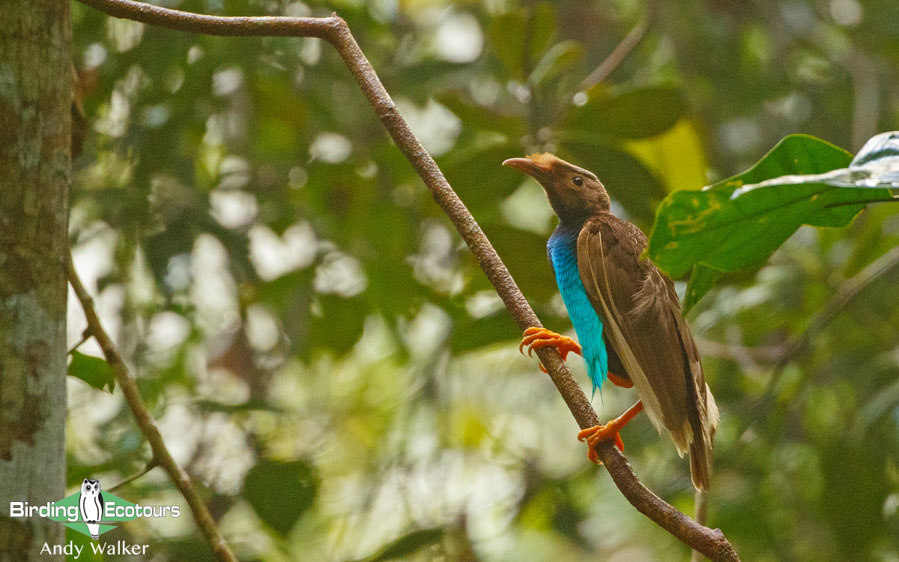
The birding on these islands is excellent, with a variety of stunningly colored endemic kingfishers which illuminate the forest in the Sulawesi lowlands (such as Sulawesi Lilac Kingfisher, Green-backed (Blue-headed) Kingfisher, and Sulawesi Dwarf Kingfisher), the Hylocitrea (a highly sought-after monotypic family), the enigmatic Geomalia (an aberrant ground thrush), and the Satanic Nightjar in the mountains. Further to the aforementioned Standardwing, the island of Halmahera also supports the huge Ivory-breasted Pitta, several spectacular kingfishers such as Common Paradise Kingfisher, Blue-and-white Kingfisher, and Sombre Kingfisher, the unobtrusive Scarlet-breasted Fruit Dove, the bizarre Moluccan Owlet-nightjar, and Halmahera Paradise-crow (a member of the bird-of-paradise family).
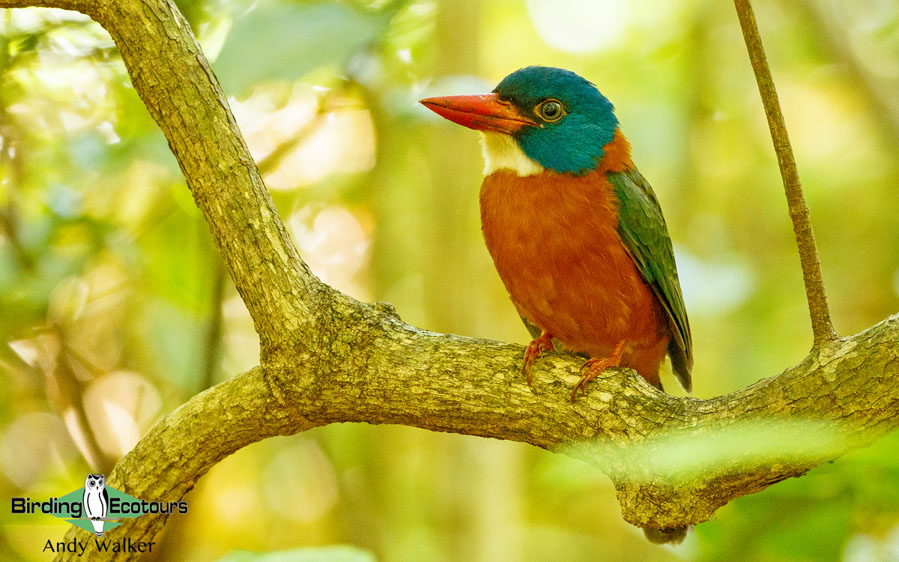
The above are just a few of the potential highlight birds we will be looking for during this tour. Some of the many other targets include Gurney’s Eagle, Sulawesi Nightjar, Purple-bearded Bee-eater, Sulawesi Pitta, North Moluccan Pitta, Invisible Rail, Blue-faced Rail, Grey-headed Fruit Dove, White-necked Myna, Red-backed Thrush, Ashy Woodpecker, Knobbed Hornbill, Sulawesi Hornbill, Blyth’s Hornbill, Yellow-billed Malkoha, Ochre-bellied Boobook, Halmahera Boobook, Scaly-breasted Kingfisher, Beach Kingfisher, Great-billed Kingfisher, Azure Dollarbird, Sulawesi Blue Flycatcher, Great Shortwing, Sulawesi Streaked Flycatcher, Malia, Rufous-bellied Triller, Piping Crow, and Goliath Coucal. There are also plenty of brightly colored parrots (especially on Halmahera, which has a more Australasian feel than Sulawesi) such as White Cockatoo, Moluccan Eclectus, Great-billed Parrot, Violet-necked Lory, Chattering Lory, Moluccan King Parrot, and Moluccan Hanging Parrot. A highly rewarding and thoroughly exciting tour is guaranteed here!
This exciting Sulawesi and Halmahera birding tour can easily be combined with some of our other Indonesian birding tours, such as those that cover the endemic-rich Lesser Sunda Islands (before this tour) or West Papua (after this tour).
Detailed Itinerary (16 days/15 nights)
Day 1. Arrival in Makassar
A non-birding arrival day into Indonesia. After your arrival in Makassar, you will be transferred to our nearby hotel for the rest of the day at your leisure. We will meet for a group welcome dinner together in the evening.
Overnight: Harper Perintis Makassar, Makassar (or similar)
Day 2. Flight from Makassar to Manado, birding Tangkoko area and mangrove boat trip
We will take a morning flight from Makassar to Manado and once we arrive in the northern city, we will drive to our base at Batuputih Bawah near Tangkoko, where we will check in to our accommodation for the next few nights.
In the afternoon we will take a boat trip into the mangroves where we will look for the localized Great-billed Kingfisher. We will also be on the lookout for Great-billed Heron, Pacific Reef Heron, Striated Heron, Brahminy Kite, White-bellied Sea Eagle, White-rumped Cuckooshrike, Common Kingfisher, Collared Kingfisher, Sacred Kingfisher, Pied Imperial Pigeon, Channel-billed Cuckoo, Lesser Frigatebird, Slender-billed Crow, and Golden-bellied Gerygone. There may be some early shorebird migrants about too, such as Eurasian Whimbrel, Grey-tailed Tattler, or Common Sandpiper.
Overnight: Tangkoko Lodge, Batuputih Bawah
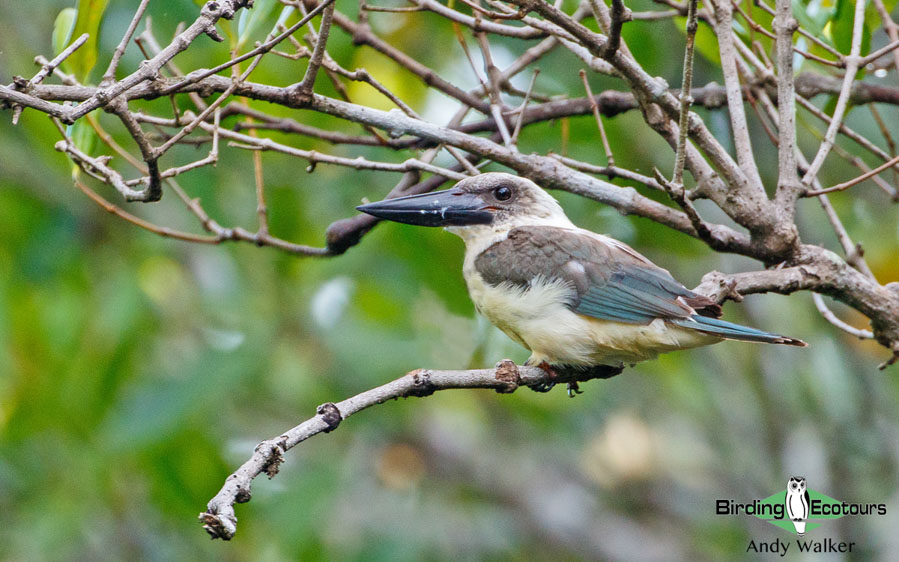
Days 3 – 4. Birding Tangkoko area (including Tangkoko Batuangus Nature Reserve and Temboan Hill)
Tangkoko Batuangus Nature Reserve is practically as far north as you can go in Sulawesi, not far from the tip of the Minahassa Peninsula – the long arm that bends out from Palu in central Sulawesi (where we will find ourselves later in the tour!). The geography of this island and adjacent Halmahera is fascinating, and the birds even more so! We are sure to really enjoy ourselves over our two full days here as we look for three gorgeous endemic kingfishers: Sulawesi Dwarf Kingfisher, Sulawesi Lilac Kingfisher, and Green-backed (Blue-headed) Kingfisher, along with beauties such as the ginormous Knobbed Hornbill and smaller Sulawesi Hornbill, gaudy Sulawesi Pitta, plus so many others like Sulawesi Hawk-Eagle, Sulawesi Serpent Eagle, Sulawesi Goshawk, Spot-tailed Goshawk, Red-backed Thrush, Philippine Megapode, Sulawesi Myna, White-necked Myna, Grosbeak Starling, White-rumped Triller, Pied Cuckooshrike, Sulawesi Cicadabird, Grey-rumped Treeswift, Yellow-billed Malkoha, Purple-winged Roller, Bay Coucal, Ashy Woodpecker, Black-naped Oriole, Hair-crested (White-eyed Spangled) Drongo, Isabelline Bush-hen, Barred Rail, Buff-banded Rail, and maybe even the mythical Blue-faced Rail, with a big dose of luck.
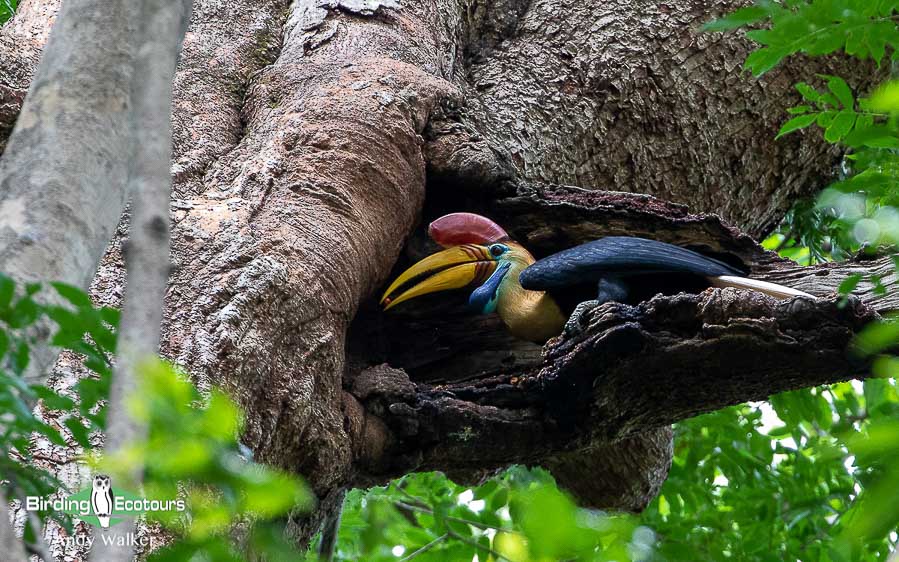
Parrots, pigeons, and doves are common here, and we could see Yellow-breasted Racket-tail, Golden-mantled Racket-tail, Azure-rumped Parrot, Ornate Lorikeet, Great Hanging Parrot, Pygmy Hanging Parrot, Silver-tipped Imperial Pigeon, Green Imperial Pigeon, White-faced Cuckoo-Dove, Black-naped Fruit Dove, Oberholser’s Fruit Dove, Superb Fruit Dove, Grey-cheeked Green Pigeon, Pink-necked Green Pigeon, Sultan’s Cuckoo-Dove, Stephan’s Emerald Dove, Spotted Dove, and Zebra Dove!
The park is great for three special mammals, and we will look for the tiny Spectral Tarsier, the smallest monkey in the world, (Sulawesi) Celebes (Black-) Crested Macaque, another interesting primate, and (Sulawesi) Bear Cuscus, a marsupial!
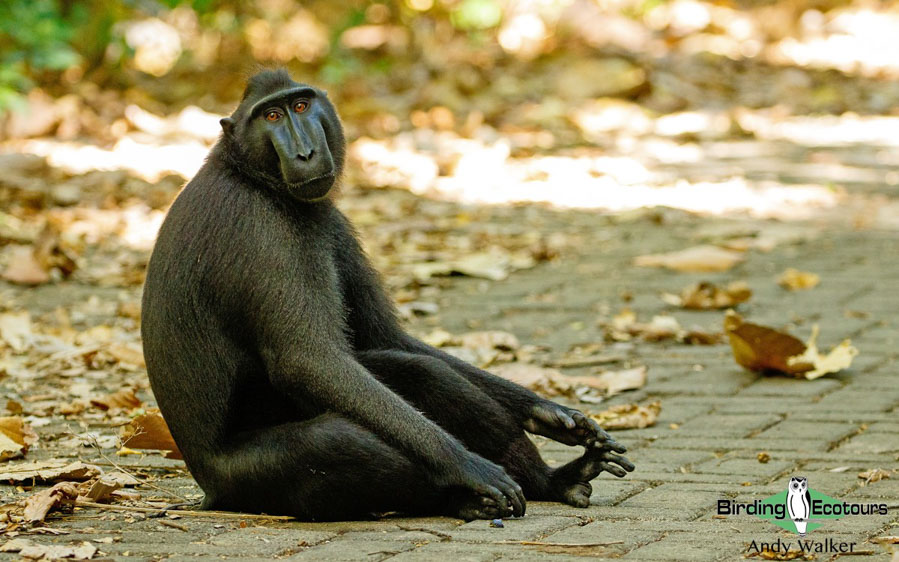
Nightbirds are usually plentiful here too and Ochre-bellied Boobook, Speckled Boobook, Minahassa Masked Owl, Sulawesi Scops Owl, Great Eared Nightjar, and Sulawesi Nightjar are all possible, and we will hope to find some of these on day roosts while we are out birding in the forest and scrub.
Overnight (two nights): Tangkoko Lodge, Batuputih Bawah
Day 5. Tangkoko to Manado
After a final morning birding the wonderful Tangkoko area, we will travel back to Manado for the evening, ready for our flight to Halmahera the following morning.
Overnight: Aston Hotel, Manado (or similar)
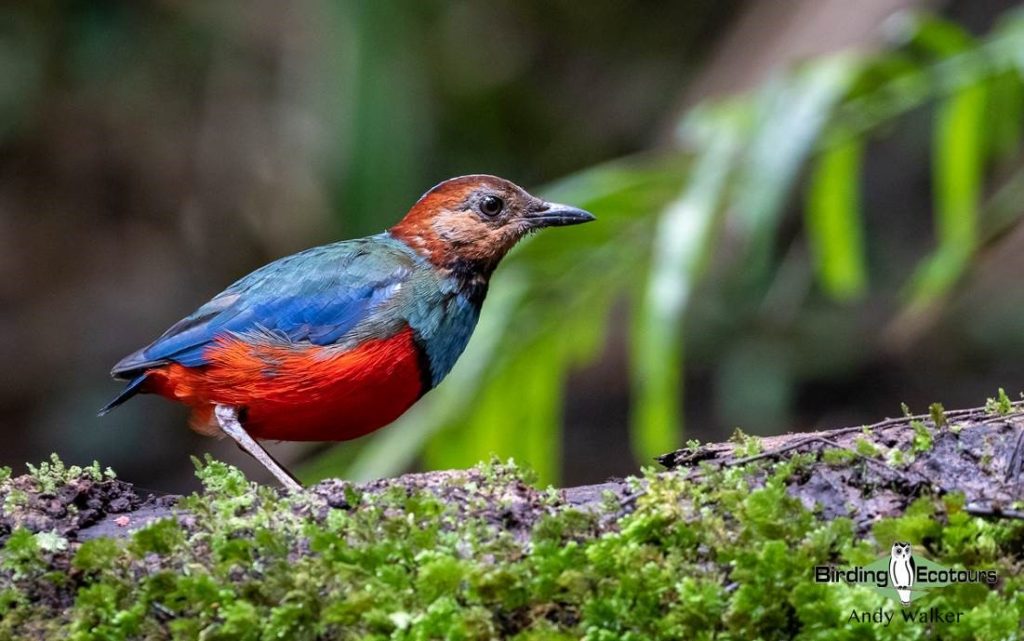
Day 6. Flight from Manado to Kao, Halmahera then on to Tobelo and Galela
After breakfast we will travel the short distance to the airport for our flight from Manado to Kao, Halmahera. We will make some roadside stops along the way to our accommodation, where we will look for Sombre Kingfisher, Blue-and-white Kingfisher, Common Paradise Kingfisher, North Moluccan Pitta, Goliath Coucal, Grey-headed Fruit Dove, Blue-capped Fruit Dove, Moluccan Cuckooshrike, Cream-throated (Halmahera) White-eye, Halmahera Paradise-crow, and Halmahera Flowerpecker.
After we arrive in Tobelo we will check in to our accommodation, have an early dinner and in the evening, we will look for Moluccan Scops Owl in some coconut plantations. Afterwards we will take canoes across to a beach area to watch the highly secretive Moluccan Megapode tend to their nests. We will be back late to our accommodation this evening.
Overnight: Greenland Hotel, Tobelo
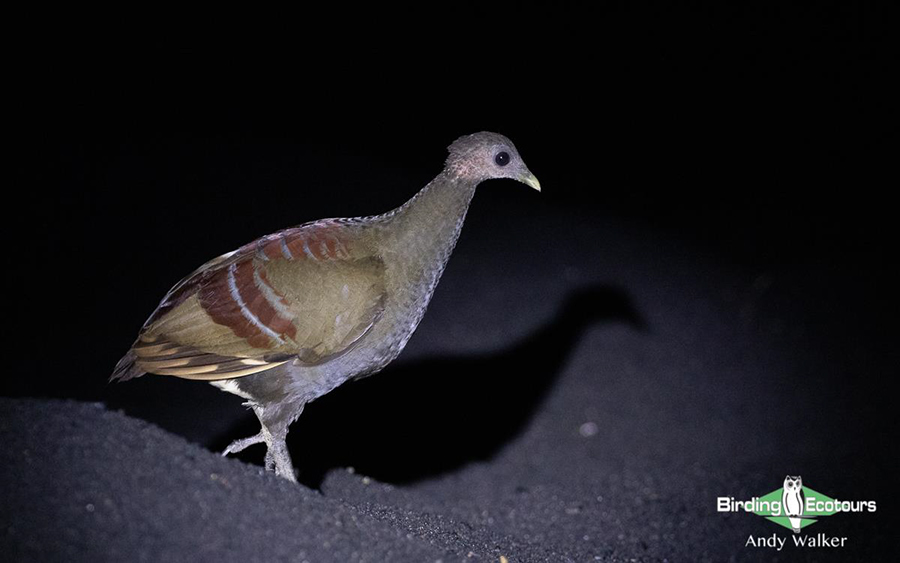
Day 7. Birding Halmahera
We will leave our accommodation early with a picnic breakfast and start the long drive towards Wasile. We will stop at Gunung Roni to look for Ivory-breasted Pitta, Azure Dollarbird, Halmahera Cuckooshrike, Moluccan Goshawk, Chattering Lory, Scarlet-breasted Fruit Dove, Drab Whistler, White (Umbrella) Cockatoo, Blyth’s Hornbill, and Gurney’s Eagle.
We will have lunch somewhere along the way, where it is convenient, there are not a lot of options along the route so it might be an early or late one depending on how the birding is going. In the afternoon we will visit Gunung Uni-uni and will bird along the roadside to Buli for White-streaked Friarbird, Halmahera (Northern) Golden Bulbul, Dusky Megapode, Moluccan Drongo Cuckoo, Violet-necked Lory, Moluccan King Parrot, Moluccan Hanging Parrot, and White-naped Monarch. In the evening (or the following morning/evening) we will look for both Moluccan Owlet-nightjar and Halmahera Boobook.
Overnight: Wisma Kita Homestay, Wasile
Day 8. Halmahera birding
We will have a very early start in order to get into place to look for the amazing (Wallace’s) Standardwing. This bird-of-paradise does not look like much in the field guides but let us assure you when you see it in real life, it is a stunner! We will then spend the rest of the day birding around the area, targeting the special birds of Halmahera.
Overnight: Wisma Kita Homestay, Wasile
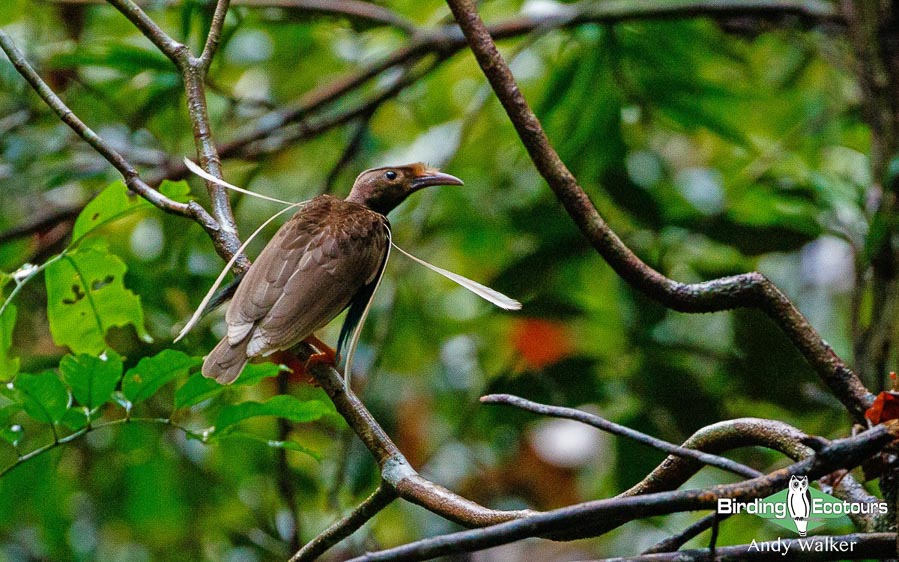
Day 9. Birding Halmahera
We will make our way from Wasile to Sofifi, birding along the way, and again we will be looking for birds mentioned in Days 6 and 7, as well as other species, including Superb Fruit Dove, Great Cuckoo-Dove, Sultan’s Cuckoo-Dove, Spectacled Imperial Pigeon, Cinnamon-bellied Imperial Pigeon, Pied Imperial Pigeon, Great-billed Parrot, Moluccan Eclectus, Red-flanked Lorikeet, Moluccan Dwarf Kingfisher, Beach Kingfisher, Rufous-bellied Triller, Dusky-brown (Halmahera) Oriole, White-streaked Friarbird, Black-chinned Whistler, Moluccan Monarch, Moluccan Flycatcher, Rufous-necked Sparrowhawk, Variable Goshawk, Moluccan Cuckoo, Rufous (Gilolo) Fantail, Island Leaf Warbler, Halmahera (Northern) Golden Bulbul, and Long-billed Crow. Late in the afternoon we will arrive in Sofifi, where we will catch a speedboat to Ternate ahead of spending the night there, ready for tomorrow’s travel day.
Overnight: Ternate Hotel, Ternate
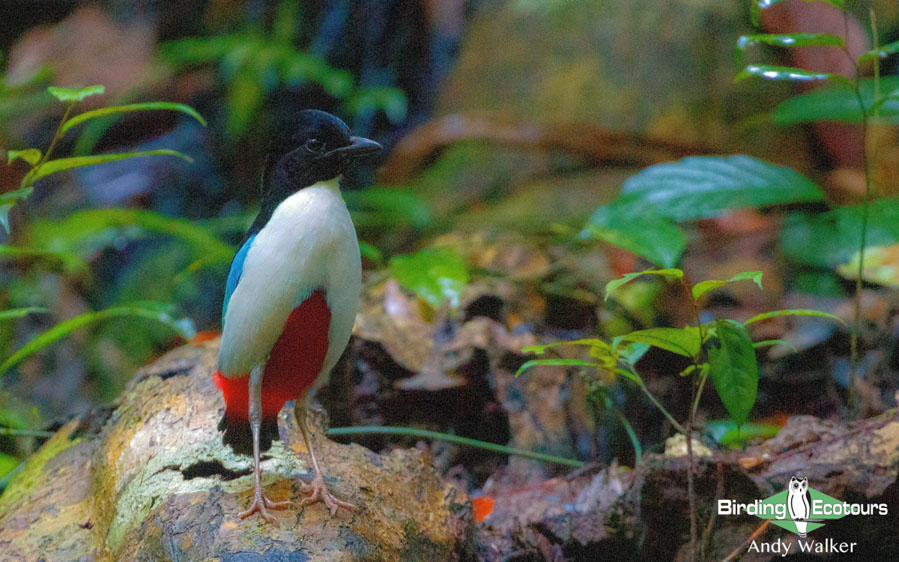
Day 10. Travel between Ternate and Luwuk (via Makassar, depending on flight routing)
A non-birding travel day as we fly between Ternate Island and Luwuk, in eastern Sulawesi. This journey will likely be via Makassar depending on flight schedules (announced nearer the time).
You might note the following in our hotel grounds in the late afternoon, if time permits: Grey-sided Flowerpecker, Black-faced Munia, and Slender-billed (Sulawesi) Crow.
Overnight: Swissbell Inn, Luwuk
Day 11. Taima – Maleo birding trip
We will have a long day today as we look for one of the most charismatic birds of Sulawesi. We will make an early start after breakfast from Luwuk in order to reach Taima on the tip of eastern central Sulawesi in the morning, where we will hope to watch a breeding colony of Maleo at fairly close quarters. The set up at this site is great, with jobs provided to local people who help monitor and protect the birds, which has massively reduced hunting pressure on this now Critically Endangered (BirdLife International) species. We will view the breeding area (a sandy beach that looks like it has had bombs dropped on it, due to all the nest holes dug by the birds!) from blinds and/or a tower hide depending on whether you like heights or not. We will view the nesting area and the birds in small groups, so as not to disturb them.
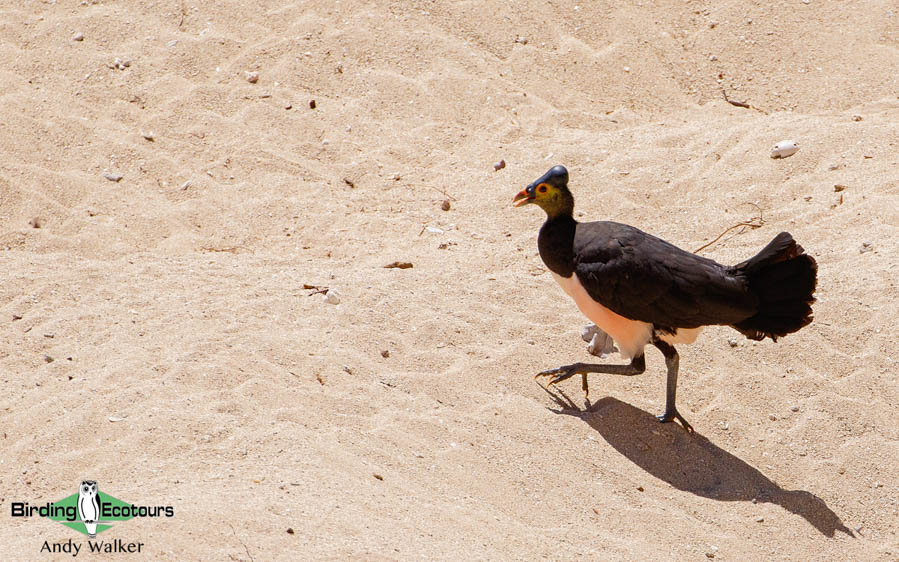
While in the area we will look out for other species that may be found here, such as White-rumped Cuckooshrike, Sulawesi Babbler, Red-backed Buttonquail, Golden-bellied Gerygone, Black-naped Oriole, Philippine Megapode, Grey-cheeked Green Pigeon, Black-naped Fruit Dove, Green Imperial Pigeon, Isabelline Bush-hen, Collared Kingfisher, Purple-winged Roller, Great Hanging Parrot, White-breasted Woodswallow, Grosbeak Starling, Hair-crested (White-eyed Spangled) Drongo, Great-billed Heron, Sulawesi Serpent Eagle, Barred (Sulawesi) Honey Buzzard, and Sulawesi Hawk-Eagle.
After lunch we will drive back to Luwuk, likely stopping at some roadside rice paddies along the way, if time permits. Today will be a long time in vehicles but it will be worth it, as we enjoy the spectacle of nesting Maleo.
Overnight: Swissbell Inn, Luwuk
Day 12. Luwuk to Palu then on to Lore Lindu
We will take a morning flight from Luwuk to Palu in central Sulawesi. On leaving the airport we will start our journey to Lore Lindu National Park, our final base for a few nights before the tour ends. Along the way we will likely stop for a few open-country birds such as Blue-tailed Bee-eater, Lemon-bellied White-eye, White-shouldered Triller, Red Collared Dove, Pale-headed Munia, Black-faced Munia, Chestnut Munia, and maybe even day-roosting Savanna Nightjar.
As we reach the Lore Lindu area we will make some roadside stops, where we might find the first of many special birds to be found here, at what is surely one of the best birding areas in Sulawesi. Some of the specials we are after include (Western) Superb Fruit Dove, Red-eared Fruit Dove, Fiery-browed Starling, Sulawesi Thrush, Pygmy Cuckooshrike, Cerulean Cuckooshrike, Great Shortwing, and the bizarre Geomalia (now considered to be an aberrant ground thrush and not a babbler as previously thought).
Overnight: Nasional Lodge, Lore Lindu Area
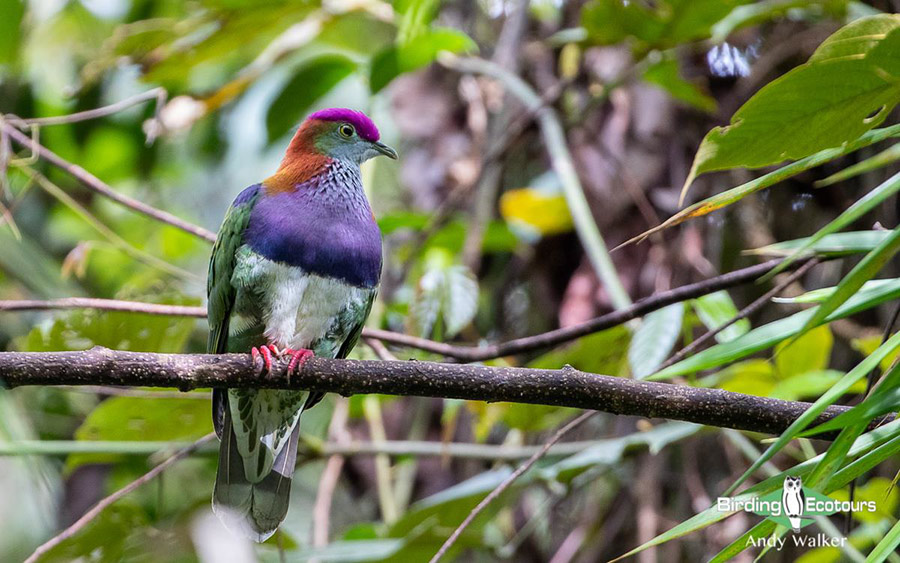
Days 13 – 14. Birding Lore Lindu National Park area (Anaso Track and Lake Tambling area)
Lore Lindu National Park protects some of the largest tracts of montane rainforests remaining on Sulawesi. We will have two full days birding here as well as the morning of Day 15. We will likely focus our birding attention on two areas while here, the famed Anaso Track (considered a tough hike) and Lake Tambling. There are a lot of new birds for us here, with potential highlights including Hylocitrea (the monotypic family), Purple-bearded Bee-eater, Geomalia, Malia, Sulawesi Streaked Flycatcher, Sulawesi Woodcock, and Satanic Nightjar.
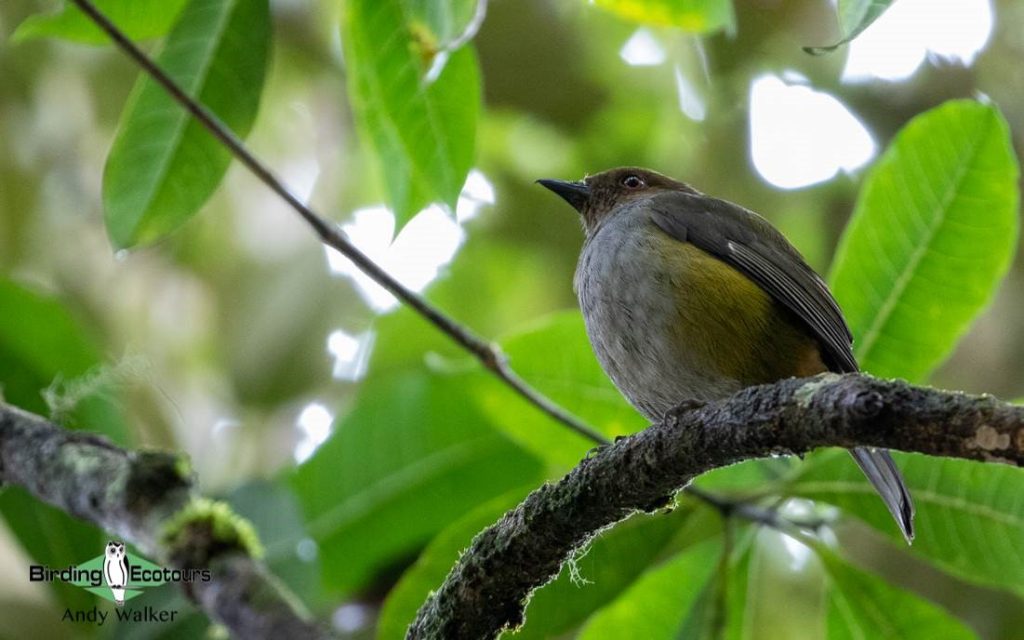
Plenty of other great species here will make our birding time very exciting. The area is excellent for pigeons and doves, and we will look for Grey-headed Imperial Pigeon, White-bellied Imperial Pigeon, Sombre Pigeon, Sulawesi Ground Dove, (Western) Superb Fruit Dove, Red-eared Fruit Dove, and Oberholser’s Fruit Dove. Additional non-passerine highlights could include Snoring Rail, Purple Needletail, Scaly-breasted (Lore Lindu) Kingfisher, Yellow-billed Malkoha, Sulawesi Hawk-Eagle, Sulawesi Hornbill, Dwarf Sparrowhawk, Spot-tailed Sparrowhawk, Eastern Grass Owl, Speckled Boobook, Cinnabar Boobook (the currently undescribed “White-spotted Boobook” form), Sulawesi Pygmy Woodpecker, Golden-mantled Racket-tail, and Yellow-cheeked Lorikeet. Meanwhile, passerine targets at Lore Lindu will include Great Shortwing, Sulawesi Thrush, Red-backed Thrush, Rufous-throated Flycatcher, Blue-fronted Blue Flycatcher, Sulawesi Blue Flycatcher, Sulawesi Drongo, Piping Crow, Ivory-backed Woodswallow, Maroon-backed Whistler, Streak-headed White-eye, White-eared Myza, and Crimson-crowned Flowerpecker.
Overnight (two nights): Nasional Lodge, Lore Lindu Area
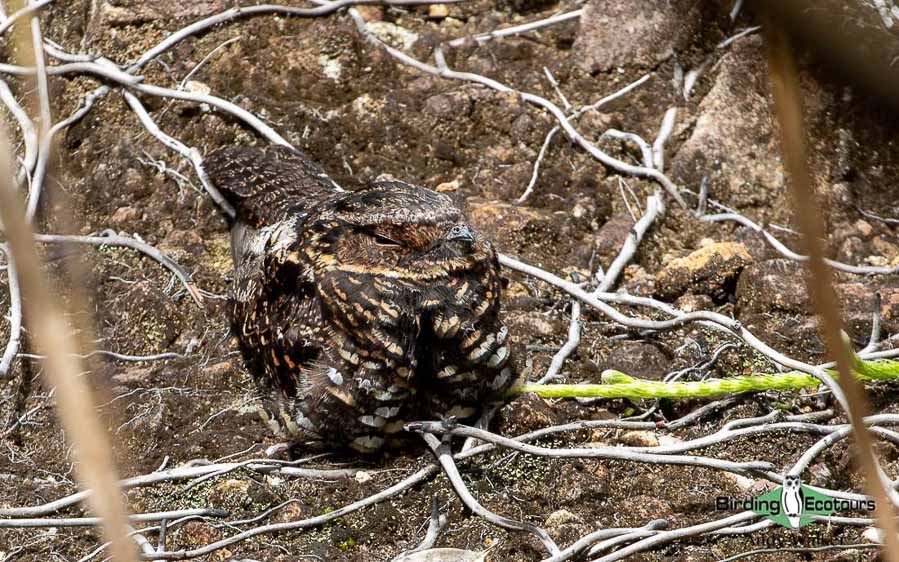
Day 15. Lore Lindu to Palu, then flight to Makassar
We will have a final morning birding around the Lore Lindu National Park area before we drive back to Palu, where we will board our afternoon flight to Makassar. We will then have our final group evening meal together.
Overnight: Harper Perintis Makassar, Makassar (or similar)
Day 16. Departure from Makassar, tour concludes
A non-birding day. The tour concludes with your departure at any time during the day (note hotel checkout is 12 noon).
Overnight: Not included
Please note that the itinerary cannot be guaranteed as it is only a rough guide and can be changed (usually slightly) due to factors such as availability of accommodation, updated information on the state of accommodation, roads, or birding sites, flight schedules, the discretion of the guides and other factors. In addition, we sometimes have to use a different international guide from the one advertised due to tour scheduling.
Download ItineraryIndonesia: Sulawesi and Halmahera –
Spectacular Endemic Birding Trip Report, July 2022
14 – 31 JULY 2022
By Andrew Walker
DOWNLOAD TRIP REPORT

Overview
This Indonesian bird tour visited the endemic-filled islands of Sulawesi and Halmahera in the transition zone between Asia and Australia, known as Wallacea. The tour started on the 14th of July 2022 in Makassar and ended back there on the 31st of July 2022. We birded around Malino, Tangkoko Batuangus Nature Reserve, Lore Lindu National Park, and Luwuk in Sulawesi, as well as across northern and eastern Halmahera. The tour featured some unseasonal poor weather, the effects of La Niña, which made conditions difficult at times and we lost some time because of rain.
We recorded 232 species on the tour (nine of these heard only). Some of the birding highlights included Moluccan Megapode, Maleo, White (Umbrella) Cockatoo, Moluccan King Parrot, Golden-mantled Racket-tail, Moluccan Hanging Parrot, Knobbed Hornbill, Sulawesi Hornbill, Blyth’s Hornbill, Goliath Coucal, Sulawesi Hawk-Eagle, Gurney’s Eagle, Pygmy Eagle, Barred (Sulawesi) Honey Buzzard, Sulawesi Masked Owl, Eastern Grass Owl, Ochre-bellied Boobook, Speckled Boobook, Halmahera Boobook, Satanic Nightjar, Scaly-breasted Kingfisher, Green-backed Kingfisher, Sulawesi Lilac Kingfisher, Great-billed Kingfisher, Blue-and-white Kingfisher, Sombre Kingfisher, Common (Halmahera) Paradise Kingfisher, Purple-bearded Bee-eater, Halmahera Paradise-crow, (Wallace’s) Standardwing, Hylocitrea, Malia, Lompobattang Flycatcher, and Lompobattang Leaf Warbler.

During the tour we found an amazing range of other wildlife too, with exciting mammals, insects, reptiles, amphibians (and others!) found. Highlights included Gursky’s Spectral Tarsier, Celebes Crested Macaque, Moor Macaque, Bornean Keeled Green Pit Viper, and almost 60 species of butterflies identified. Full species lists are provided at the end of the report.
Detailed Report
Day 1, 14th July 2022. Arrival in Makassar, Sulawesi
An arrival day in Makassar, Sulawesi with a group welcome dinner together in the evening.
Day 2, 15th July 2022. Makassar to Malino
After breakfast we transferred from Makassar to Malino, in the hills to the east of the city. We checked into our hotel and had lunch, where we saw Sulawesi Pygmy Woodpecker, Black Sunbird, and several other species. In the afternoon we drove into the hills and took a fairly tough hike, finding Lompobattang Flycatcher, Lompobattang Leaf Warbler, Black-ringed White-eye, Turquoise Flycatcher, Sulawesi Myzomela, and several other species along the way.
Day 3, 16th July 2022. Malino to Rammang-Rammang
We spent the morning back on the mountain gaining better views, of Lompobattang Leaf Warbler. Mixed flocks were busy and included Sulawesi Fantail, Citrine Canary-flycatcher, Sulawesi Pygmy Woodpecker, Black-ringed White-eye, Warbling White-eye, Sulawesi Myzomela, Sulphur-vented Whistler, Crimson Sunbird, Black Sunbird, Crimson-crowned Flowerpecker, and Yellow-sided Flowerpecker. Overhead we noted Barred (Sulawesi) Honey Buzzard, Woolly-necked Stork, Glossy Swiftlet, and Grey-rumped Treeswift. The majority of the afternoon was spent driving to Rammang-Rammang but we did enjoy seeing a family group of Sulawesi Masked Owls at our accommodation in the evening.
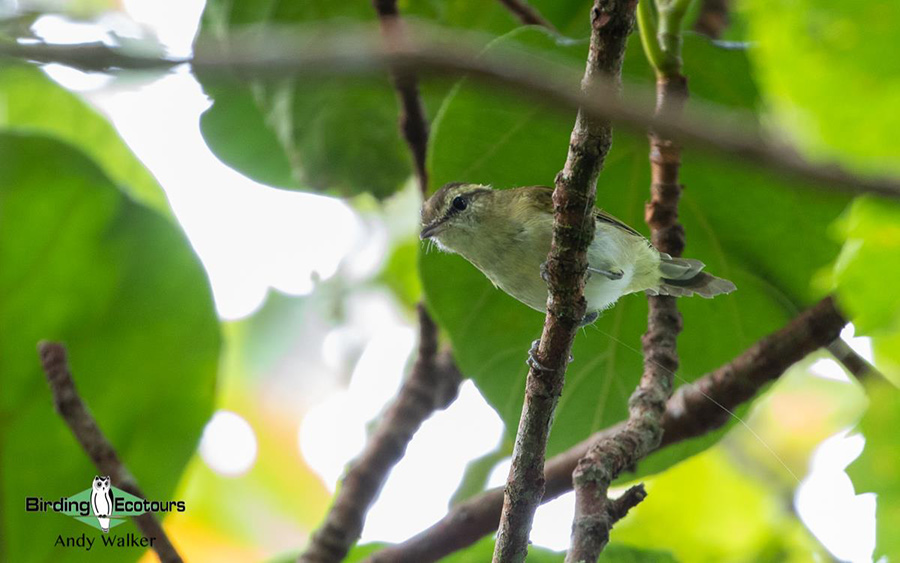
Day 4, 17th July 2022. Morning birding Rammang-Rammang, afternoon flight to Manado
In the morning we took a short walk near to our accommodation, passing through some rice paddies and into some beautiful limestone karst forest. One of the highlights of the morning was seeing a few Sulawesi Hornbills, fairly small birds by Asian hornbill standards, but still rather attractive. Other highlights from the forest included displaying White-faced Cuckoo-Dove, Sultan’s (Sulawesi) Cuckoo-Dove, Black-naped Fruit Dove, Black-naped (Sulawesi Golden) Oriole, Hair-crested (White-eyed Spangled) Drongo, Sulawesi Babbler, and Crimson Sunbird. The rice paddies gave us Chestnut (Black-headed) Munia, Black-faced Munia, Rusty-breasted (Sulawesi Brush) Cuckoo, Rainbow Bee-eater, Collared Kingfisher, and Sacred Kingfisher. The non-avian highlight was a troop of Endangered (IUCN) Moor Macaques.
As we took a short boat ride from our accommodation to our tour bus, we noted several groups of Sunda Teals. Once on dry land we headed for the airport in Makassar for our flight north to Manado. On arrival in a very wet Manado, we continued straight to our accommodation at the edge of Tangkoko National Park, for our three-night stay in this exciting area.
Day 5, 18th July 2022. Birding Tangkoko Batuangus Nature Reserve
We spent the morning battling the weather in Tangkoko Batuangus Nature Reserve, unseasonal rain was the order of the morning, a result of La Niña. Despite the poor conditions we found several good birds and animals with the highlights including Celebes Crested Macaque, (Sulawesi) Bear Cuscus, Green-backed Kingfisher, Ashy Woodpecker, Silver-tipped Imperial Pigeon, Green Imperial Pigeon, Sultan’s (Sulawesi) Cuckoo-Dove, Philippine Megapode, Slender-billed (Sulawesi) Crow, and Grosbeak Starling. By the middle of the morning the rain had become too heavy to continue so we made a hasty retreat to our accommodation for lunch and a siesta.
In the afternoon, once the rain had stopped, we took a drive to a river estuary where we picked up our boat and took a ride up the river. Our main target was Great-billed Kingfisher and almost at the end of the day we got some good views of this large species. While looking for this bird we also found Common Kingfisher, Sacred Kingfisher, and Collared Kingfisher, along with other species, including Grey-tailed Tattler, Pink-necked Green Pigeon, Grey-cheeked Green Pigeon, and several other goodies.
Day 6, 19th July 2022. Birding Tangkoko Batuangus Nature Reserve
We awoke to a dry day, which was a relief after the previous day! A pair of Yellow-billed (Sulawesi) Malkohas were in the garden of our accommodation and showed nicely. We again went into the park and had a couple of Philippine Megapodes right away. We took a long and winding walk this morning and it was rather tiring, but it was interspersed with some great birds, and top of the pile was the male Knobbed Hornbill that we watched after staking out its nest. Watching this spectacular giant bird posting small figs through to the female for around ten minutes will not be forgotten any time soon. We waited a while for it to come in, but it was more than well worth the wait! We also got incredible looks at Sulawesi Lilac Kingfisher as well as good views of Green-backed Kingfisher, Ochre-bellied Boobook, Ashy Woodpecker, and more. Non-avian highlights were many, and included more sightings of Celebes Crested Macaque, along with Whitish Dwarf Squirrel, Celebes Dwarf Squirrel, and tree-roosting Lesser False Vampire bats. Butterflies were impressive today too, particularly Common Birdwing and Blanchard’s Ghost.
We had another walk in the park during the afternoon and picked up some more bird sightings, including Purple-winged (Sulawesi) Roller, but best of all was our sightings of a few Gursky’s Spectral Tarsiers, magnificent little critters!
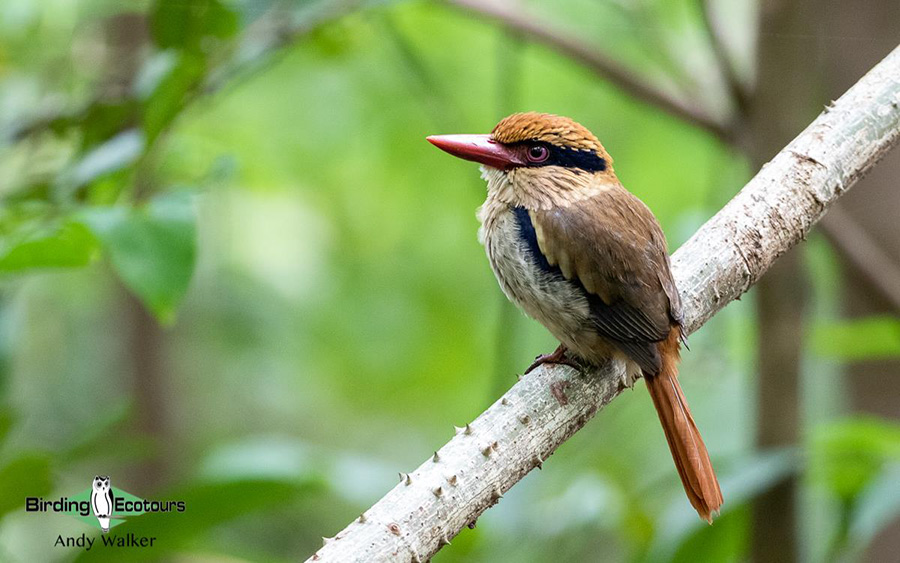
Day 7, 20th July 2022. Temboan Hill and travel to Manado
We had a relaxing day today as we recovered from the physical exertions of the past couple of days! Our morning birding took us to nearby Temboan Hill, where we waited to see what would fly by or fly in and land for us. During this birding session we found a flock of foraging Knobbed Hornbills, distant but still impressive. We also had perched Azure-rumped Parrot, Great (Sulawesi) Hanging Parrot, Silver-tipped Imperial Pigeon, Green Imperial Pigeon, Grey-cheeked Green Pigeon, and Black-naped Fruit Dove. Black-naped (Sulawesi Golden) Orioles were in evidence, as were flocks of Grosbeak Starlings and a single White-necked Myna. The birding ended with a pair of huge Channel-billed Cuckoos flying right over our heads – a most impressive sight!
In the afternoon we drove to Manado for a relaxing afternoon, before preparing for our journey to Halmahera the following day.
Day 8, 21st July 2022. Manado, Sulawesi to Kao, Halmahera, then Moluccan Megapode Trip
Mainly a travel day as we made our way from Manado in northern Sulawesi to Kao in northern Halmahera. Roadside birds noted once on Halmahera included Oriental Dollarbird, Willie Wagtail, and Northern (Halmahera) Golden Bulbul.
After dinner we took a trip north in our cars, then took a canoe across a river mouth, and sat and waited on a beach in the dark for one of the coolest birds in Indonesia… After an hour or so of sitting patiently on the beach we were rewarded when a Moluccan Megapode flew in calling then proceeded to tend to its nest. We got exceptional views of this shy and uncommon bird and was definitely another contender for “Bird of the Trip”. It was a late night, but well worth the adventure.
Day 9, 22nd July 2022. Birding northern Halmahera
We spent the day driving from northern to eastern Halmahera but made several roadside birding stops along the way. Across the course of the day, we found several top targets, including White (Umbrella) Cockatoo, Halmahera Paradise-crow, Moluccan Hanging Parrot, Blyth’s Hornbill, Gurney’s Eagle, Blue-and-white Kingfisher, White-streaked Friarbird, Long-billed Crow, Rufous-bellied Triller, Grey-headed Fruit Dove, Eclectus Parrot, Violet-necked Lory, Red-cheeked Parrot, Northern (Halmahera) Golden Bulbul, Halmahera Flowerpecker, and plenty more!
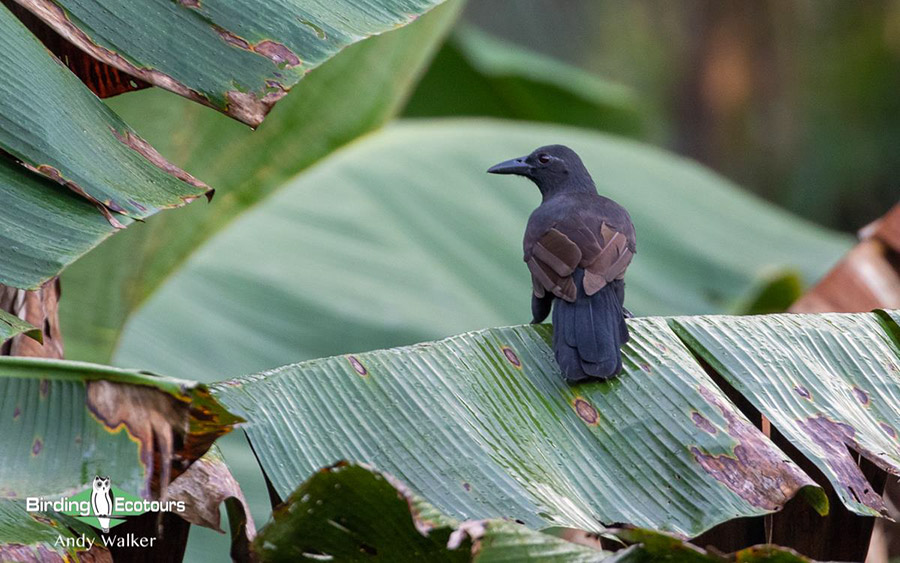
Day 10, 23rd July 2022. Birding Halmahera for (Wallace’s) Standardwing
We had a very long day, but it was well worth it with loads of great birds. An early start saw us in a 4×4 vehicle climbing into a patch of forest where we had fleeting glimpses of a pair of Halmahera Boobooks. Shortly afterwards we commenced our hike down a slope and got into place as the sounds of the forest came alive with the introduction of our main target for the day, the impressive (Wallace’s) Standardwing (Bird-of-paradise). We spent quite a bit of time watching the birds at their lek, one male attracting the attention of three females! After enjoying our time with these great birds we hiked back up the hill and enjoyed breakfast in the forest. We then took a walk along road in some partially logged forest, this walk yielded some great birds, including Moluccan Monarch, Moluccan Flycatcher, White-naped Monarch, Moluccan Cuckooshrike, Rufous-bellied Triller, Common Cicadabird, Dusky-brown (Halmahera) Oriole, (Halmahera) Spangled Drongo, Drab Whistler, Moluccan Myzomela, and Pacific Baza. The trail was also alive with butterflies and dragonflies, which provided lots of distractions!

In the late afternoon we visited a different patch of forest where we found some more great birds, this included the impressive Goliath Coucal, displaying Great Cuckoo-Dove (wow!), and several pigeons attracted to a fruiting tree, featuring Cinnamon-bellied Imperial Pigeon, Grey-headed Fruit Dove, and Sultan’s (Sultan’s) Cuckoo-Dove. Scarlet-breasted Fruit Dove and Spectacled Imperial Pigeon were heard too, but remained hidden, as did Ivory-breasted Pitta. Other birds seen in the area included Blyth’s Hornbill, Chattering Lory, Moluccan Hanging Parrot, White (Umbrella) Cockatoo, Long-billed Crow, Torresian Crow, and Moluccan (Halmahera) Goshawk. We tried for Moluccan Owlet-nightjar after dark, but unfortunately it just wouldn’t come in, so remained heard only.
Day 11, 24th July 2022. Halmahera Birding
We spent the morning back at the spot from the previous afternoon and once the low cloud lifted, we found some quality birds. A fruiting tree (different to the previous one) held foraging Scarlet-breasted Fruit Dove, Cinnamon-bellied Imperial Pigeon, and a few (Wallace’s) Standardwings (Bird-of-paradise). Working the area, we also found Black-chinned (Moluccan) Whistler, Island (North Moluccan) Leaf Warbler, Moluccan Starling, Moluccan Monarch, Moluccan Myzomela, and Moluccan Cuckooshrike. Several parrot species were moving around and included White (Umbrella) Cockatoo, Moluccan King Parrot, Eclectus Parrot, Red-cheeked Parrot, Chattering Lory, Red-flanked Lorikeet, and Moluccan Hanging Parrot. Moving around a bit we also found Variable Goshawk, Pygmy Eagle, Goliath Coucal, and Blyth’s Hornbill.
In the afternoon we commenced our journey from Wasile to Sofifi. We made several birding stops along the way and some of the highlights included Common (Halmahera) Paradise Kingfisher, Sombre Kingfisher, Blue-and-white Kingfisher, Moluccan Cuckooshrike, White-bellied Cuckooshrike, and Goliath Coucal.
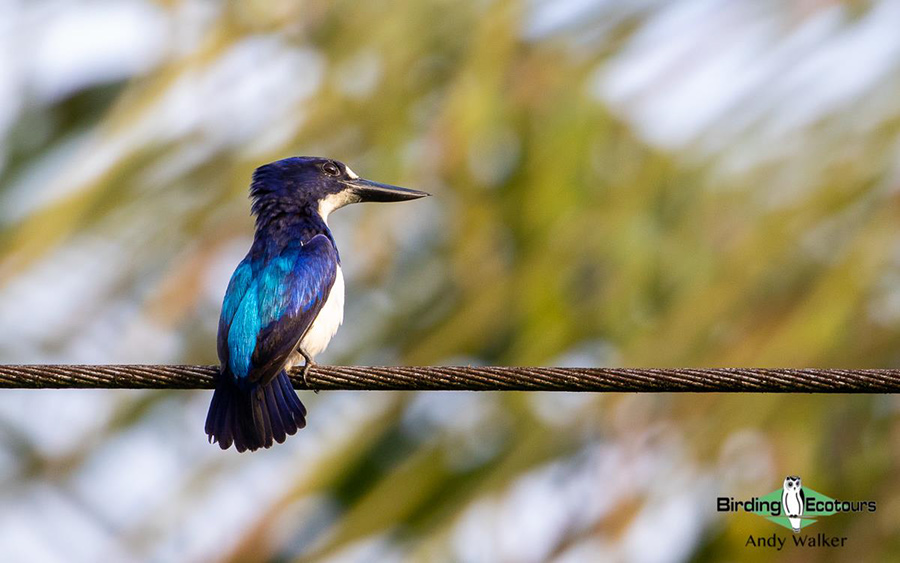
Day 12, 25th July 2022. Halmahera to Ternate to Makassar
A travel and relaxing day as we made our way from Sofifi, on Halmahera, to Ternate City, on Ternate in a speedboat, and then on to Makassar via a short flight. The afternoon was spent at leisure around our comfortable hotel near the airport.
Day 13, 26th July 2022. Makassar to Luwuk
Another travel day as we made our way from Makassar to Luwuk, in preparation for the exciting adventure awaiting the following day!
Day 14, 27th July 2022. Maleo Birding Trip to Taima
A day of atrocious weather as we drove from Luwuk to Taima and back again. Remarkably, and luckily, the one hour of dry weather all day coincided with our time looking for the main event for the day, the nesting Maleo. We had excellent views of a dozen or so birds tending their nests on the beach, and was another tour highlight. It was also great to learn a bit about the conservation work underway in the area to protect this species.
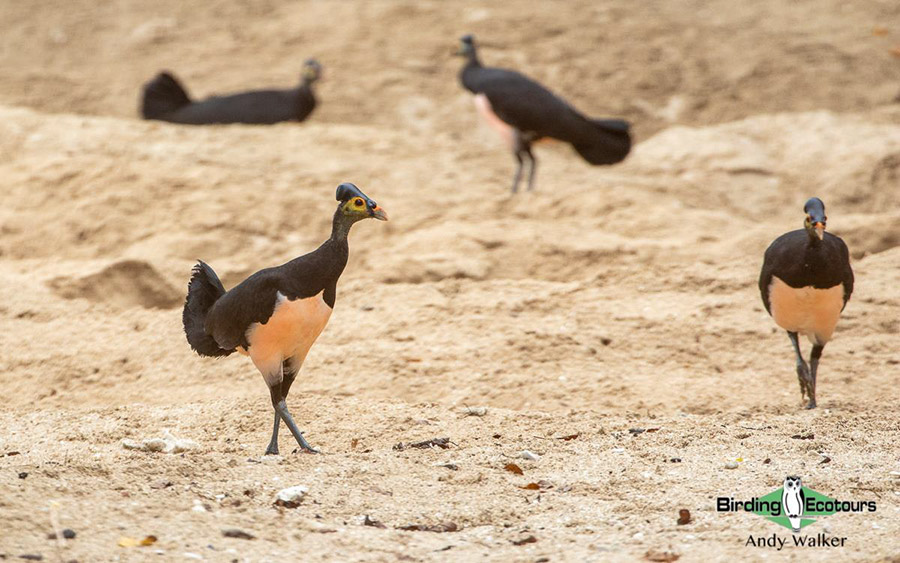
After enjoying our fill of the Maleo we had a little look around the immediate area and found White-rumped Cuckooshrike, Black-naped (Sulawesi Golden) Oriole, Hair-crested (White-eyed Spangled) Drongo, Yellow-billed Malkoha, Pacific Reef Heron, and Brown Booby.
During the journey birding opportunities were limited, mainly due to the pouring rain for the majority of the time, though we did note Spotted Harrier, White-necked Myna, White-faced Cuckoo-Dove, Sultan’s (Sulawesi) Cuckoo-Dove, Purple-winged Roller, Sunda Teal, and a few assorted kingfishers, herons and egrets in the rice paddies.
Day 15, 28th July 2022. Luwuk to Palu then Lore Lindu
We took our morning flight out of Luwuk (where it had finally stopped raining) to Palu. We headed immediately into some scrub and rice paddies where we found Black-faced Munia, Chestnut (Black-headed) Munia, Pale-headed Munia, Savanna Nightjar, Little Bronze Cuckoo, Red-backed Buttonquail, White-shouldered Triller, Lemon-bellied White-eye, Wood Sandpiper, and a few other birds.
After lunch we commenced our drive to Lore Lindu. On our arrival in the national park we started birding immediately and got going with Cerulean Cuckooshrike, Fiery-browed Starling, Sulawesi Blue Flycatcher, Sulawesi Drongo, Little Pied Flycatcher, Citrine Canary-flycatcher, Black-crowned White-eye, Sulawesi Myzomela, Dark-eared Myza, and several other species. Excitement near the end of the day came in the form of a simply stunning Bornean Keeled Green Pit Viper (found by Andy while watering the trees….)!
Day 16, 29th July 2022. Birding Lore Lindu National Park (Anaso Track) and wider area
We spent the morning birding along the famous Anaso Track in Lore Lindu National Park. It’s a long uphill hike, but one of the main target birds of the tour, Hylocitrea, is best observed there, and we were rewarded with some excellent views of a bird feeding on some low-hanging fruit. We spent quite a bit of time with this bird as it was showing so well, and it was a joy to watch. There were plenty of other high-quality birds during the morning, with two of the best being Scaly-breasted (Lore Lindu) Kingfisher and Satanic Nightjar. The former vocal but rather shy and the latter roosting out in the open giving amazing views.
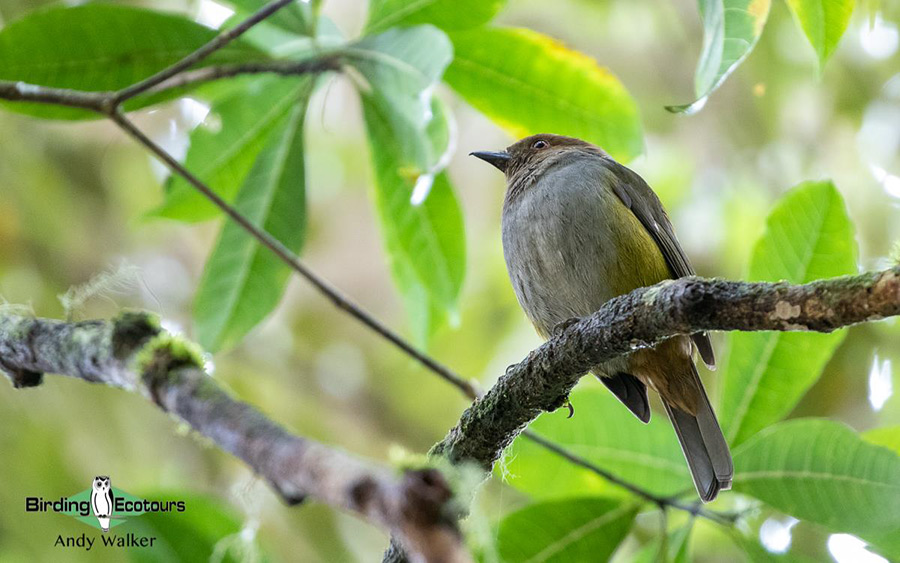
Other birds noted during the hike included White-bellied Imperial Pigeon, Golden-mantled Racket-tail, Malia, Cerulean Cuckooshrike, Pygmy Cuckooshrike, Sulawesi Leaf Warbler, Sulawesi Fantail, Sulphur-vented Whistler, Streak-headed White-eye, Snowy-browed Flycatcher, and Blue-fronted Blue Flycatcher.
After a bit of a rain shower in the middle of the day we headed out to some nearby rice paddies where we found a different mix of birds, including Buff-banded Rail, King Quail, Common Moorhen, Black-backed Swamphen, Glossy Ibis, Oriental Darter, Pacific Black Duck, Tawny Grassbird, Barn Swallow, Black-winged Kite, and on dusk, a few Eastern Grass Owls.
Day 17, 30th July 2022. Birding Lore Lindu National Park
We spent the morning birding in Lore Lindu National Park and had a great time seeing lots of exciting birds. Early on, a mixed flock kept us entertained and contained Sulawesi Thrush, Malia, Sulawesi Drongo, Ashy Woodpecker, Streak-crowned White-eye, and Sulawesi Fantail. Birding around the campground yielded nest-building Yellow-cheeked Lorikeet, Pygmy Cuckooshrike, Black-billed Koel (a mating pair sat out in the open), Turquoise Flycatcher, Sulawesi Babbler, Sulawesi Myzomela, and plenty of white-eyes.
Moving along the road we found more great birds, including Purple-bearded Bee-eater, Sulawesi Myna, Ivory-backed Woodswallow, Sulawesi Hawk-Eagle, Black Eagle, Superb Fruit Dove, White-bellied Imperial Pigeon, and Dark-eared Myza.
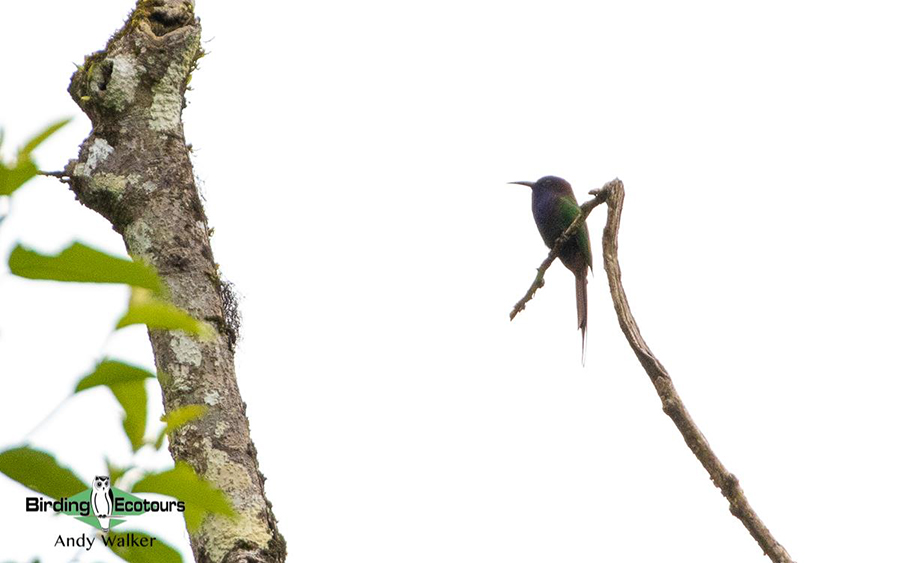
In the afternoon we headed back out into the national park again and enjoyed more great birds, until the rain came and ended things prematurely. Some of the top picks included an incredibly showy pair of (Western) Superb Fruit Doves, Grey-headed Imperial Pigeon, White-bellied Imperial Pigeon, Sulawesi Hawk-Eagle, Crimson Sunbird, and a gorgeous Fiery-browed Starling giving the best views so far.

Day 18, 31st July 2022. Birding Lore Lindu. Travel to Makassar via Palu and tour concludes
We had a final couple of hours birding in Lore Lindu National Park before we needed to head down to Palu to catch our flights to Makassar, where the tour concluded. Before we said our goodbyes, we enjoyed final looks at Malia, Sulawesi Thrush, Red-eared Fruit Dove, Sulawesi Hawk-Eagle, Cerulean Cuckooshrike, Pygmy Cuckooshrike, Sulawesi Leaf Warbler, Crimson-crowned Flowerpecker, and Blue-fronted Blue Flycatcher.
Thanks to everyone for making this a thoroughly enjoyable tour, despite the unseasonal poor weather. The vote for “Bird of the Trip” resulted in the following four excellent choices coming out on top: Moluccan Megapode, Maleo, Knobbed Hornbill, and Hylocitrea. A notable mention must also go to the displaying Great Cuckoo-Dove, which was simply spectacular and took us all by surprise! We also included a vote for “Animal of the Trip”, as we’d seen so many cool creatures (over 130 non-bird taxa identified), and this resulted in a tie between Gursky’s Spectral Tarsier and Bornean Keeled Green Pit Viper (photos below). Good choices all round, with special mention to the Amboina Sailfin Lizard that ran across a small pond, and a whole host of gorgeous butterflies and moths that frequently had us gasping in astonishment at their beauty.
The bird and animal trip lists are given below, along with taxonomic notes on the birds following the bird list.
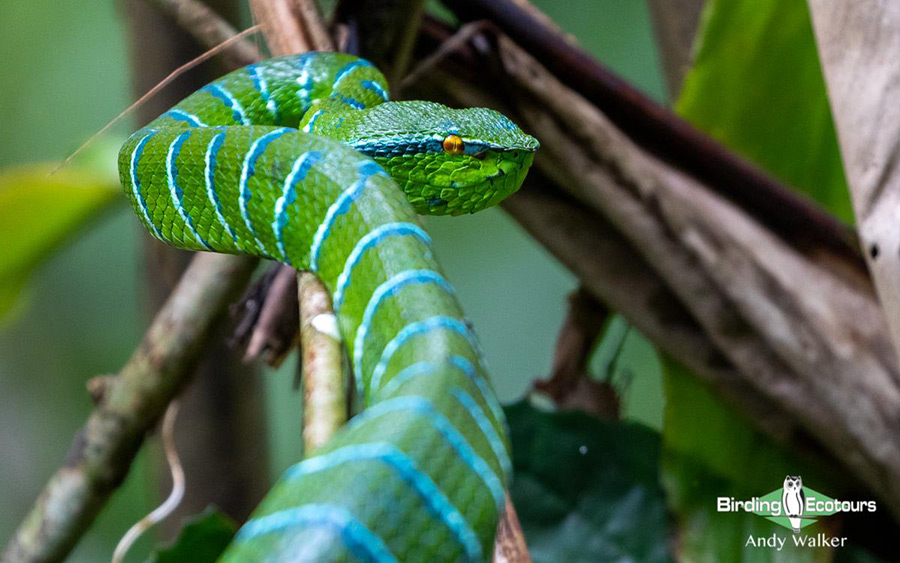
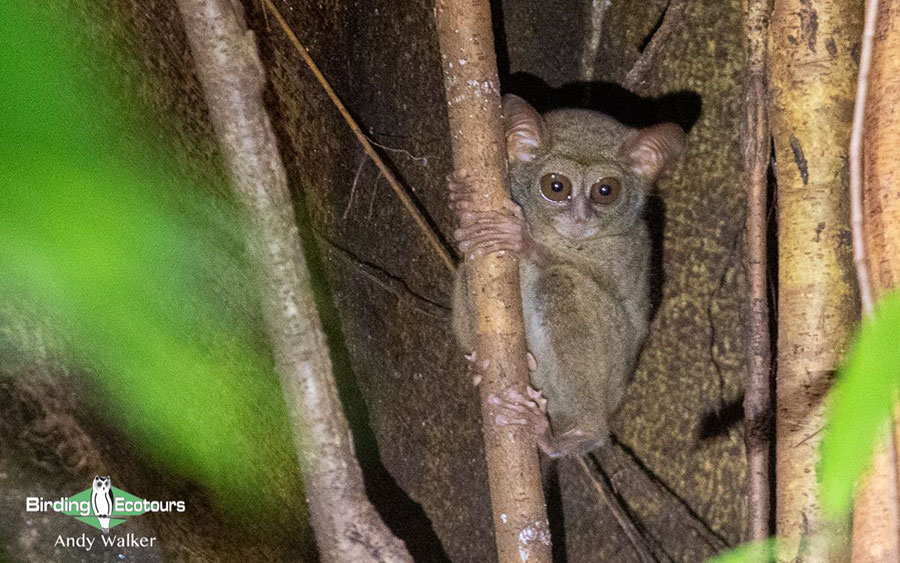
DOWNLOAD TRIP REPORT
Please see the downloadable PDF above with the full species lists included. This is a sample trip report. Please email us ([email protected]) for more trip reports from this destination.
For more information please also read our two blog posts on Sulawesi and Halmahera.
Indonesia: Sulawesi and Halmahera – Spectacular Endemic Birding
Tour-Specific Information
GENERAL INFORMATION ABOUT INDONESIA CAN BE READ HERE
TOUR OUTLINE
This is an absolutely thrilling endemic-packed birding tour covering the two Indonesian provinces of Sulawesi and Halmahera. This tour starts and ends in Makassar, South Sulawesi and visits some of the best birdwatching sites in the whole of Indonesia. The list of possible birds on this tour is extraordinary and includes Maleo, (Wallace’s) Standardwing (a stunning bird-of-paradise), Ivory-breasted Pitta, Hylocitrea (a monotypic family), Satanic Nightjar, Moluccan Owlet-nightjar, Purple-bearded Bee-eater, Knobbed Hornbill, and a plethora of fruit doves, pigeons, parrots, owls, kingfishers, and more (see the detailed itinerary for a mouthwatering read!). The habitats we cover are varied and loads of the birds will give excellent views and good incidental photos of many will be possible. The landscapes we will see from land, water, and the sky are spectacular, particularly if you like staggering volcanoes cloaked in rainforests and palm-fringed coastlines with beautiful beaches and mangroves.
DAILY ACTIVITIES, PHYSICAL REQUIREMENTS, AND TOUR PACE
This Sulawesi and Halmahera birding tour needs reasonable fitness and agility as the tour, by its nature, covering such a large area, goes at a fairly quick pace with the focus on finding as many of the endemic birds and regional specials as possible. There are many early starts, late finishes, and long days.
Some of the areas we are birding in are fairly remote, even by Indonesian standards, Halmahera more so than Sulawesi. It will be important to remember that you are visiting a developing country and will be staying in remote areas, where there are limited sanitation facilities. Expect many things to be very different from home, or even other parts of Indonesia. Notwithstanding the above, we have tried to make this tour as comfortable as possible by staying in trusted accommodation that is of the highest standard in the local area, so that the free time between birding sessions is as comfortable and relaxing as possible, but note this may still be quite basic in some places (such as at Lore Lindu and on Halmahera particularly). The closure of Weda Dive Resort in Halmahera is a real shame (for visitors to the island, the local bird guides who used to work there, and the birds), and has made visiting Halmahera tougher.
The nature of travel in this part of Indonesia requires multiple internal flights and/or long drives to get to the different birding spots. This can be rather tiring at times. We will have long days in the field, though often, when the situation allows, we will rest during the heat of the middle of the day (when bird activity is lower). We will usually have an early breakfast (sometimes this will be a boxed breakfast) before we head out birding. Lunch will usually be back at our accommodation or a restaurant but occasionally might be ‘in the field’ as a boxed picnic lunch. Dinner will most often be back at our accommodation or a nearby restaurant. There are a lot of nightbirds possible on this tour so there will be several night birding sessions either after dinner, or sometimes before dinner (with a later mealtime being on the cards).
While the majority of the birding is carried out on roads and flat tracks, some of these occur at elevation and some are interspersed with steep inclines and declines. Several of the trails can be swampy and wet (even in the dry season) and can be slippery. One hike in Sulawesi, along the famed Anaso Track in the spectacular Lore Lindu National Park, is considered difficult. It’s not particularly steep (as like some of the trails on our West Papua tour), but it is long and tiring (c. three miles / five kilometers each way). Walking sticks or hiking poles are a great idea as they provide added stability to help with balance and are compulsory for anyone who is not steady at walking. We take this track slowly as we will be birding along the way, so most people should be able to manage it given the slow pace we will be walking. In Halmahera, the hiking for the (Wallace’s) Standardwing lek is considered a tough hike. The location visited might change each year but in 2022, visiting the lek required a tough downhill hike for around 30-minutes, with a tough hike back up (taking longer) afterwards, particularly when the heat and humidity have been added to the equation. Our local guides are always on the lookout for easier to reach lek sites and we will choose the best one available during the time of our visit.
On some occasions we have need to venture “off-piste”, for example if we need to look for a roosting owl, a hornbill nest, a bird-of-paradise lek, or a pitta – the sort of birds unlikely to be seen right from the trail. We have local guides and other support staff with us, so if at any time anyone in the group wants to opt out of an activity that will be possible, and we will give you as much information ahead of time as we can.
The weather is likely to be hot and humid for most of the tour (except for time at elevation, but even here it shouldn’t feel particularly cold), this can make the birding tiring. The tour is scheduled for the dry season, but rain can fall at any time in this area.
TRANSPORTATION AND SEAT ROTATION
We use several forms of transport on the tour. During the tour we will likely use a range of minibuses of varying sizes, and sometimes 4×4 vehicles. The common 4×4 in this part of the world is the Toyota Hilux, so we are likely to use those, or similar. We require that you are fit and flexible and can maneuver yourself into (and out of) these high-clearance vehicles.
During our time in vehicles, we operate a rotation policy so that everyone has the same opportunities with seating positions. All participants will be expected to honor this. Issues such as suffering from motion sickness will not excuse you from this policy, so please bring medication if you think this could be an issue for you. Some of the roads we will be driving along will be windy and are rough in places. We also ask everyone to please be aware of the amount of extra equipment they bring into the seating area of the vehicles as there will not be much extra space. Some of the drives between cities/airports and our accommodation/birding sites will be up to four or five hours. Typically, we will drive to an area, stay there for a few nights and thoroughly explore it before moving to the next place, so there are limited one-night stays in our itinerary, though occasionally these are needed to work with domestic flights, of which there are at least six on this tour (see “Domestic Flights” below, for specifics).
We will use a speedboat to get between Halmahera and Ternate (before a flight to Sulawesi) and we will take a smaller outrigger boat for a mangrove boat trip in Sulawesi. The speedboat between the two islands involves proper harbors but might include climbing up or down a ladder or walking across other boats, and so a bit of agility might be required, though boat crews and local guides will be able to help here. This trip can last between 30-60 minutes depending on the tide/weather and there are no opportunities for birding off the speedboat (there is little to be expected from the crossing really) and it might be bumpy. The boat trip to the mangroves is a birding trip. It may result in wet/sandy feet as we enter and exit the boat on the beach at the start and end of the trip, which usually lasts a couple of hours. We ride the boat from the beach along the coastline before turning into a river mouth where we spend most of the time looking for birds in the mangroves.
DOMESTIC FLIGHTS
This Indonesian birding tour starts and ends in Makassar, however there are multiple (at least six) domestic flights required. See the tour map tab for a better understanding of the tour route. The costs for these domestic flights are included in the tour cost. The domestic flights are as follows: Makassar – Manado, Manado – Kao, Ternate – Makassar, Makassar – Luwuk, Luwuk – Palu, and Palu – Makassar. Domestic flights in Indonesia usually have a hold luggage weight limit of 44 pounds (20 kilograms) with a hand luggage allowance of 15 pounds (7 kilograms). Overweight baggage will likely incur additional costs and will be the responsibility of the individual to pay, these costs will need to be paid for in cash to the airline while at the airport, and often take some time, so adhering to the baggage allowance is best for everyone in the group to prevent undue stress for everyone. Note the itinerary may change if flight schedules change at all, which is beyond our control, of course.
LUGGAGE
Please note the expected maximum weight allowances for the domestic flights. Due to the route we take, all luggage will need to be carried for the duration of the tour and luggage cannot be left somewhere to be picked up later, so should not exceed this weight. Please therefore pack as lightly as possible. A medium, soft-sided, strong duffle bag (not the hard-sided cases) is likely to work best for packing in the tour vehicles (noting that this will include minibuses, 4×4 vehicles, speedboats, and planes). We recommend a daypack is used to keep items that you wish to use daily when in the vehicle, in the field, and for hand luggage when flying, this should be of the standard size acceptable to fit in the overhead luggage compartments in planes too.
SAFETY
Your safety is our paramount concern on all our tours, that’s why we try and provide you with as much thorough general and tour-specific information as possible ahead of the tour, which in this case visits very remote areas in Indonesia.
The political situation in Central Sulawesi (where we visit when birding Lore Lindu National Park) is considered “unsettled” by the United Kingdom government (and see also US government information here), and includes Palu, Poso, and Tentena. These areas have the potential for politically motivated violence. We will keep clear of all protests, demonstrations, and political rallies as they can turn violent without warning. There is ongoing conflict between Indonesian security forces and terrorists in the vicinity of Lore Lindu National Park. The conflict is predominantly concentrated in the Sigi, Parigi Moutong, and Poso Regions. From time-to-time areas of the national park can be closed totally or restricted and possible only with armed guards. We keep in frequent contact with our local guides who live in the area for the latest news. When birding in this area, our activities will be based on the current situation. From time to time the Anaso Track can be closed by the police and obviously if that happens it is beyond our control.
Care should be taken when in cities, airports, and ports where petty theft (e.g. pickpockets etc.) can be a concern. If you want to go walking around outside the city hotels when in Makassar or Palu (such as for going to a shop to purchase a SIM card or some snacks), please be aware of your surroundings. The pavements are often dangerous with uncovered drains.
Trips and falls when on trails, tracks/roads, and while getting into or out of the vehicles or boats are all possibilities on this tour and care should be taken, especially when conditions are boggy or slippery in the forest, which can occur even during the dry season. A walking stick or hiking pole is compulsory if you are at all unsure on your feet. Note we will, at times, venture off marked trails/roads in pursuit of certain target birds.
Natural disasters such as earthquakes, tsunamis, volcanoes, and flooding are frequent across Indonesia, the country sits on the “Ring of Fire”. We will be monitoring the situation in the lead up to, and during the tour. Be aware that a volcanic eruption far away from the tour location can cause flight delays, for example should a volcano erupt in or near the Indonesian international airports in Bali or Java.
Insect repellent with a high DEET concentration can be useful for keeping mosquitoes away. Sulawesi and Halmahera have a low malaria risk (consult your doctor or travel clinic), but prevention of bites is recommended. DEET insect spray can also keep chiggers and leeches away. Chiggers, especially prevalent at Tangkoko National Park, can lead to Scrub (Bush) Typhus and can be incredibly irritating as well as potentially leading to medical complications. Leeches do not spread diseases, but they are rather unsettling, and can cause blood loss. Rubber boots can help with reducing issues with chiggers and leeches.
When in Tangkoko National Park we will (hopefully) enjoy seeing and photographing the (Sulawesi) Celebes (Black-) Crested Macaque. Although these monkeys sometimes allow a close approach, they are totally wild animals and should be treated as such. When viewing monkeys, let them approach you on their own terms. If you stoop down and avoid looking directly in their eyes, they will be less aggressive. Do not chase or pursue monkeys and never feed them. No matter how innocent they may look, wild monkeys bite and can carry dangerous diseases and the nearest decent hospital is over a two-hour drive away.
WEATHER/CLIMATE
While in the lowlands of Sulawesi we can expect average daytime highs of around 85–95 F (30–35 C) and average nighttime lows of 70–75 F (21–24 C), it could be a touch hotter when in Halmahera. Although there is often a lot of cloud cover at this time of year, the sun is strong, and care should be taken to remain hydrated and use sun protection to reduce the chance of sunburn. It can be very humid in both Sulawesi and Halmahera.
In the mountains (e.g. at Lore Lindu National Park in Sulawesi) it is cooler than the lowland temperatures and we can expect average daytime highs of around 68–77 F (20–25 C) and average nighttime lows of 50–59 F (10–15 C). Note we don’t actually stay overnight in the mountain, we stay in the nearby valley, so nighttime temperatures at the accommodation are not as cold as in the mountains, but cooler than other locations we stay overnight.
Rain is possible at any time, at any location so rain gear and an umbrella will be useful. A dry bag is also recommended for protecting optics, electrical equipment/cameras, and important documents (see the “What to Bring: Clothing and Other Items” section below) in the case of an unexpected thunderstorm and downpour.
ACCOMMODATION
All accommodation has been chosen for its proximity to excellent birding locations while still providing an adequate level of comfort, where possible. While in Sulawesi we stay in accommodation ranging from good hotels in the towns and cities, such as in Makassar, Manado, and Luwuk, to more basic yet comfortable lodges catering for birders when at Tangkoko National Park and at Lore Lindu National Park.
All accommodation in Sulawesi, apart from that at Lore Lindu National Park (where it is not necessary) has air conditioning. All accommodation has western style toilets and en suite bathrooms (these are basic at Lore Lindu National Park) and are clean and comfortable. Hotels in the cities have Wi-Fi and there is phone signal. There is no Wi-Fi and very limited phone signal when we stay near Tangkoko National Park. There is no Wi-Fi or phone signal when we stay near Lore Lindu National Park (but there is phone signal in the national park hear the headquarters due to a recently installed mast) and the electricity might go off here during the daytime. Most of the city hotels have swimming pools (e.g., Makassar, Manado, and Luwuk).
In Halmahera, since the sad closure of Weda Dive Resort, we have had to change our accommodation choice. We now stay in a couple of basic homestays and/or basic hotels as there is limited choice in the areas we will be staying. The quality of the accommodation is considered lower than that in Sulawesi. The accommodation we use have private basic en-suite facilities and all have fans or air-conditioning. In Ternate we stay in a hotel in the city that is one of the best available with air-conditioning or a fan.
The beds in most places we stay usually have thin and hard matrasses, as is typical in many Asian countries.
ELECTRICITY
The electricity is likely to go off at our accommodation at Lore Lindu National Park during the middle of the day, but we should not have issues elsewhere, unless something unexpected happens, such as a thunderstorm taking out the supply somewhere.
COMMUNICATIONS
Phone signal is limited (or absent) for some of the tour route, particularly when we are in Tangkoko National Park and when on Halmahera. You may be able to use an international phone roaming package while in Indonesia, but it may be expensive. You can purchase a local SIM card for use in Indonesia when at the airport, however it can be a complex process and the rules over foreigners using local SIM cards changes all the time. If you purchase a SIM card on a different island it might not work on other islands, without adding specific “local” data/credit, this needs to be done at a convenience store in cash. If you are going to need phone signal – where there is some – during the tour, please let us know as we might be able to purchase SIM cards in advance depending on the current rules in place, which do change without warning. It might be simpler to rely on Wi-Fi when we are passing through airports and staying in city hotels, such as in Makassar, Manado, Luwuk, and Ternate, etc., or using your international SIM with a suitable roaming package.
FOOD AND MEALS
Food is of local Indonesian style in most places. The majority of the food on the tour is rather basic. Some of the larger hotels in the towns and cities may have more western style food (or a local take on what that should be and varies in quality depending on location), but this is not necessarily to be expected. Bringing energy/cereal bars might be advantageous for during early morning hikes. When we are in remote parts of Sulawesi, such as Lore Lindu National Park, and the duration of our time in Halmahera and Ternate, food will be basic to very basic.
Please remember to give us your dietary preferences. Are you vegetarian? Can you eat spicy foods, etc.? In some areas we visit (particularly on Halmahera) it will be difficult to find decent vegetarian food.
We will have quite a few early starts on this tour and so breakfasts in hotels are likely to be early, as a consequence though, on some occasions we might have a boxed breakfast. Most of the time, we will have lunch back at our accommodation or a nearby restaurant, though we might also have a picnic-style boxed lunch on some occasions. Many of the meals in hotels and restaurants will entail an assortment of meat (chicken and fish) and vegetable dishes being supplemented with rice and noodles, these will be shared amongst the group. Evening mealtimes will vary day to day due to the nature of the birding. We have several evenings of night-birding to fit in and on these occasions, we might have an evening meal later (or earlier) than usual. If you have to eat meals at certain times, such as for medication purposes, please bring a supply of snacks to do so.
MONEY
It is recommended that you either bring a supply of Indonesian rupiah with you from home or withdraw some cash from the international airport that you arrive at. We will pass through Makassar airport several times during the tour, and this will be one of the better opportunities to get cash out of ATMs as there is usually some choice of banks/ATMs to use. Other cities we pass through, such as Manado, Palu, and Luwuk could allow for money to be withdrawn but it is not uncommon to have difficulties in some of the more remote areas and small towns. Not all banks/ATMs accept all foreign cards and charges are likely to apply. We are unlikely to be able to draw cash while in Halmahera, though as we drive from the airport to the harbor in Ternate, we might be able to get some cash.
Most extra purchases/personal expenses are likely to require payment in cash, with the exception of hotels in major cities where cards are likely to be accepted.
WHAT TO BRING: CLOTHING AND OTHER ITEMS
The following is a list of useful items to bring on this Sulawesi and Halmahera birding tour and should be read in conjunction with the Indonesia general information document.
- A field guide to the region. We recommend the following book for this tour:
- Birds of the Indonesian Archipelago: Greater Sundas and Wallacea – James A Eaton et al. (2021), Lynx Edicions. 2nd We recommend the Flexibound version of the 2ndedition of this book, rather than the hardback or 1st edition versions that are also available.
- Hiking pole or walking stick to help on the tracks and trails. A walking stick is compulsory for anyone who is unsteady walking, as we feel this is a safety issue; we don’t want anyone slipping on the trails or anywhere else. Please discuss with us if you are unsure whether you will need one or not.
- Torch (flashlight) and/or headlamp is essential kit. Needed for owling (so you can see where you are walking) and when we set off on our birding in darkness (e.g. when we head up the Anaso Track in Lore Lindu National Park or when we hike to the (Wallace’s) Standardwing Headlamp is best to keep hands free for hiking pole/walking stick.
- Insect repellant with a high DEET concentration.
- Leech socks – can be useful, if it is unseasonably wet.
- A small personal first aid kit. See the items recommended by the Centers for Disease Control and Prevention (CDC), here. There are pharmacies in the cities we pass through, but we will only have limited access to these, so it is best to be prepared. When we are in remote Sulawesi or Halmahera there is very little (or nothing at all) available in terms of medical supplies.
- Although footwear is a matter of personal preference, rubber boots can be extremely helpful, particularly in muddy/swampy conditions, they are also very good for keeping chiggers away from your skin, a very useful trait, particularly at Tangkoko National Park. A negative aspect to rubber boots is that they often lack suitable ankle support provided by walking/hiking boots (especially useful on the hike up the Anaso Track which is a rocky road) and can make your feet/legs rather sweaty in the heat to be expected. If you don’t mind getting dirty (and potentially bitten by chiggers), in favor of better ankle support, go with walking boots and a good covering of DEET. It may be possible to purchase rubber boots on arrival in Makassar ahead of the tour starting should you wish, assuming they have your size (not a certainty here).
- Quick-drying clothes are the best for this tour and a minimum of a fleece/jacket should be carried for time at the higher elevations such as at Lore Lindu National Park, where it can be cooler in the early mornings and evening/overnight.
- Rain jacket (and small umbrella).
- Swimwear if you want to make use of the swimming pools at the city hotels if time permits.
- We find that a small hand towel or wash cloth can be handy for cleaning and drying items when in the rainforest.
- A dry bag to keep valuable documents in such as passports, cell phones, wallets etc., as well as cameras if it rains.
- Power bank – useful to keep items such as cell phones fully charged, but we should have electricity for most of the time on this tour. Can be useful when we have long drives or long travel days etc.
“Andy is a first-rate guide; his ability to direct people on to a bird is tremendous. He is also not just a birder; on this trip we also ended up with over 100 invertebrates fully identified; great for the all-round naturalist! Always affable, and with the best interests of his clients in mind; I look forward to more trips with him in the future”.
Kelvin, UK.
